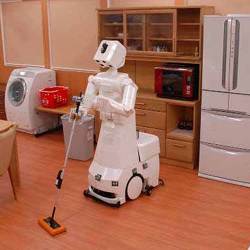
The invasion has begun; they live among us. Rolling, crawling, and walking beside us, they study us, becoming more intelligent with each passing day. The day of the robot revolution is not standing still.
We may be unsure of exactly what they might dream, but robots are rapidly becoming a fixture in our homes. They have been vacuuming our floors for years, and now they clean grills, cut the grass, and provide home security. They may not quite have the functionality or design of The Jetsons’ Rosey the Robot, but robots with equivalent capability, and even appearance, are on the near horizon.
“A lot of people would like to have (Rosey) around the house, and we are getting there,” said Philip Solis, research director at ABI Research. “Today, we have mostly single-task home care robots. One or more for your floor, one for your lawn … maybe you can combine vacuuming and floor-mopping. Build a larger base, and add some articulation so that it can pick up toys, know where to put them, clean the blinds, and wipe down the cabinets. The technology is rapidly evolving.”
Available now and in pre-production are myriad robotic machines for the home, from helpbots to personal drones to toys, sometimes offering a potential for personal attachment not possible with traditional home care products.
ABI Research estimates the consumer robotics market totaled $3.5 billion in 2015 and will grow to $17 billion by 2025. Juniper Research estimates that while only one in 25 American households owned a consumer robot in 2015, the robotic presence in U.S. homes will grow to one in 10 households by 2020. The International Federation of Robotics estimates 5.4 million service robots for personal and domestic use were sold in 2015, at a value of $2.2 billion.
Some home robotic devices currently on the market include the iRobot Looj
 gutter cleaner, Friendly Robotics’ grass-cutting Robomow
gutter cleaner, Friendly Robotics’ grass-cutting Robomow
 , the Litter Robot
, the Litter Robot
 to patrol and eliminate waste from cat owner’s litter boxes, the Nanda Clocky
to patrol and eliminate waste from cat owner’s litter boxes, the Nanda Clocky
 that gives sleepers only one snooze period before forcing action by rolling away, and the Jibo social robot
that gives sleepers only one snooze period before forcing action by rolling away, and the Jibo social robot
 , which provides conversation, as well as hands-free smart home control and voice interaction with Internet services.
, which provides conversation, as well as hands-free smart home control and voice interaction with Internet services.
Home robotics growth is being driven by a reduction in prices due to technology improvement and increased sales/production volumes, coupled with advances in capability. A functional “Rosey” built 10 years ago would have required PC-level computing power and cost as much as $100,000, Solis said; today, a robot with similar or even improved functionality is possible using a smartphone-level processing platform, and would cost perhaps $2,000. That’s still a bit high for the consumer market, but steadily moving toward a tipping point.
“You look at the social robots evolving today, there is no real articulation,” he said. “They are basically embodied smartphones. Greater tasks will be absorbed into a more complicated robot.”
Juniper senior analyst Steffan Sorrell cautions that personal robots “are heavily limited by present-day technology … (and) to meet consumer expectations, smarter, more contextually aware robots are required.” A major step involves “cost and trust,” as even though component costs are declining, a potential hurdle is evolving as some studies show the trust level between robot and human appears to eroding.
One company attempting to bridge the gap between consumer robots and immediate functionality is Travelmate Robotics, which has developed what it calls a “robot companion” in the form of a fully autonomous suitcase. The suitcase is designed to roll untethered beside or behind the user, with an ability to move vertically or horizontally while smoothly navigating through crowds, recognizing and avoiding potential objects and individuals that could block its path. The related smartphone app allows the owner to name the suitcase robot, a move intended to increase bonding between human and machine.
“We want people to have a personal attachment to it,” said David Near, CEO of Travelmate Robotics. “It is a buddy that follows you around, a robot friend.”
The company focused on suitcases as a path to providing “the first true robot companion that is consumer-ready in terms of real functionality and pricing,” Near said. The suitcases, which start at about $400 for a carry-on, utilize a Bluetooth connection to the owner’s smartphone. They equipped with omni wheels to effectively negotiate inclines and uneven terrain, as well as battery power sufficient to operate in full autonomous mode for four hours. The suitcase can be used to charge cellphones, has a USB port, and is designed to accommodate a laptop computer on top to make it a portable office. It comes with three GPS chips, and weighs the loaded suitcase to eliminate surprises at check-in.
With a camera mounted, the suitcase can act as a video assistant, holding the camera securely while moving to tracking filmed subjects. The suitcase may also potentially be used as a security robot, patrolling perimeters of homes, Near said.
As home robots evolve, they will likely continue to look more like a “Rosey” than becoming more human-like in appearance. Adopting more human features involves additional levels of technology and cost, and moves toward the “Uncanny Valley” first identified by robotics professor Masahiro Mori in 1970, which suggests humans become increasingly uneasy as robots approach a very high level of human appearance.
Technology will trickle down from military and industrial designs, which are already taking on the look of science fiction, with robots from companies like Boston Dynamics that resemble insects, giant dogs, speedster giant cats, and more traditional androids.
Home robot design will evolve naturally, ABI’s Solis said, as the environment robots need to address is dominated by accommodation for human morphology.
“Cabinets, knobs, everything really, favors some degree of a humanoid robot; tall and upright, with arms of some type. You’ll probably need the screen or ‘face’ elevated on a pole, kind of like a fancy selfie stick,” he said, “but making robots extremely real, with skin and human features? There really is no need, and you want to avoid that.”
Darrell Dunn is a freelance writer and editor based in the Dallas-Fort Worth area.




Join the Discussion (0)
Become a Member or Sign In to Post a Comment